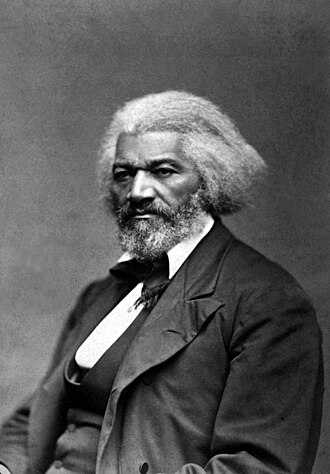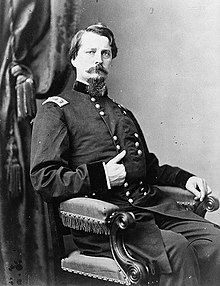Chapter XXXVIII, 1880
At the Whig convention, there was little doubt of who the presidential nominee would be. Allegations of corruption, however, meant that there would be an effort by some delegates to replace Colfax. They drafted General William Tecumseh Sherman, who was not consulted and had no desire to run for president. Anti-Colfax efforts predictably failed. The much more serious contest at the convention would be the vice-presidential nominee. Greeley, the incumbent, was in poor health and this information was known by most of the delegates as he was too ill to attend the convention. On the first ballot, Greeley failed to win a majority. The two other main contenders were Senator James G. Blaine of Maine and former Postmaster General Cassius Marcellus Clay, a powerful figure within the Whig Party. In the end, Clay won out. Just like the Democrats, the Whigs rejected the progressive policy planks in the platform. The Whig Party was the party of industrialists, not labor unions. And just like the Democrats, the Whig Party pledged to support the Gold Standard against bimetallism or paper currency.

(Cassius Marcellus Clay)
The Whigs were not in an enviable position. The Colfax administration was accused of corruption, the economy was in a recession, and people were weary of twelve years of full Whig control. Attacking the Democrats as the party of the Confederation was wearing off quickly, as the party had nominated generals twice in a row. But Colfax had two causes for optimism. One was that hundreds of thousands of black Southerners were registered to vote for the first time. The other was that Butler had split from the Democratic Party. Butler was also a cause for some concern. Colfax understood that many Whigs would be sympathetic to his message. After all, it would be impossible to become governor of Massachusetts without appealing to at least some Whig voters. The coalition that had put Fremont into power was united on the issue of slavery, but held widely divergent views on other matters. And for this reason, Whig politicians and voters were already switching to the Democratic Party, narrowing the Whig majority in Congress.
Butler tried to win voters from both parties. He even attempted to win the endorsement of Frederick Douglas by claiming he would do more for the black man than Colfax. Douglas, though sympathetic to Butler, ultimately decided to support Colfax. The Whigs had ended slavery and were protecting the rights of freedmen. Douglas was not eager to abandon a friendly administration for an upstart party that had little chance of success. Most black voters felt the same. In Louisiana, however, there were many former slaves who remembered Butler as the man who gave them freedom and would vote for him in November. This was the first time the black vote was contested. Butler’s base of support was not in the South. He was popular in the West and in his home state of Massachusetts. The Farmer-Labor Party ran candidates for local elections as well, especially in Kansas, Nebraska, Iowa, and Utah. Butler had little hope of winning the election outright. Instead, his strategy was to build a base of support on which he could expand in 1884.

(Frederick Douglas)
The election of 1880 saw Democrats gain in the North and Whigs gain in the South. This would be the first election since 1868 in which every state would participate. South Carolina held a popular vote election for president for the first time. In the end, the Whigs won the popular vote in both the North and the South. They did, however, fall three votes short of the 184 votes needed to win the electoral college. This was mainly due to extremely narrow losses in Missouri (376 votes) and Massachusetts (359 votes). The election would be thrown to the House. Colfax could safely count on 12 state delegations; Vermont, Maine, Rhode Island, Connecticut, Pennsylvania, Michigan, Wisconsin, Minnesota, Utah, Mississippi, Alabama, and South Carolina. Hancock could also count on 12; New Hampshire, New York, New Jersey, Maryland, Delaware, Indiana, Illinois, California, Oregon, New Mexico, Missouri, and Arkansas. Several representatives supported Butler, and thus Massachusetts, Iowa, Louisiana, and Kansas were deadlocked. Soon, Kansas and Nebraska pledged to support Butler. Kentucky, Georgia, and Florida got behind Colfax. Texas threw its support to Hancock.
Meanwhile, Democrats made a deal with Butler’s supporters. They would support some of their policies in return for votes for Hancock. In all likelihood, the Whigs made a similar offer. But Democrats were set to take the House, so they would have more power. Kansas, Nebraska, Iowa, Louisiana, and Massachusetts went into Hancock’s column. 18 state delegations supported Hancock, 15 supported Colfax, and four (Ohio, Virginia, North Carolina, and Tennessee, were divided. One Virginia Whig changed his vote to Hancock, and with that he won the election. Democrats would have the presidency once more. In the Senate, the vote was between the top two, so only Clay and Tilden were in the running. The Whig majority in the Senate meant that Clay would win the Vice Presidency after one vote. For the first time since 1796, a President and Vice President elect would be from different parties. The election of Clay as Vice President meant that Whigs would maintain control of the Senate. Greeley, meanwhile, had recovered by the time of the election and later claimed that he voted for Butler after feeling betrayed by the Whig Party.

Schuyler Colfax (W-IN)/Cassius Marcellus Clay (W-KY): 4,062,121 Votes (46.09%), 181 Electoral Votes
Winfield Scott Hancock (D-CA)/Samuel J. Tilden (D-NY): 3,896,695 Votes (44.21%), 164 Electoral Votes
Benjamin Butler (FL-MA)/James B. Weaver (FL-IA): 841,214 Votes (9.55%), 21 Electoral Votes [1]
Others [2]: 13,054 Votes (0.14%), 0 Electoral Votes
1: Includes a faithless elector from New York
2: Prohibition and Socialist parties.

(Cassius Marcellus Clay)
The Whigs were not in an enviable position. The Colfax administration was accused of corruption, the economy was in a recession, and people were weary of twelve years of full Whig control. Attacking the Democrats as the party of the Confederation was wearing off quickly, as the party had nominated generals twice in a row. But Colfax had two causes for optimism. One was that hundreds of thousands of black Southerners were registered to vote for the first time. The other was that Butler had split from the Democratic Party. Butler was also a cause for some concern. Colfax understood that many Whigs would be sympathetic to his message. After all, it would be impossible to become governor of Massachusetts without appealing to at least some Whig voters. The coalition that had put Fremont into power was united on the issue of slavery, but held widely divergent views on other matters. And for this reason, Whig politicians and voters were already switching to the Democratic Party, narrowing the Whig majority in Congress.
Butler tried to win voters from both parties. He even attempted to win the endorsement of Frederick Douglas by claiming he would do more for the black man than Colfax. Douglas, though sympathetic to Butler, ultimately decided to support Colfax. The Whigs had ended slavery and were protecting the rights of freedmen. Douglas was not eager to abandon a friendly administration for an upstart party that had little chance of success. Most black voters felt the same. In Louisiana, however, there were many former slaves who remembered Butler as the man who gave them freedom and would vote for him in November. This was the first time the black vote was contested. Butler’s base of support was not in the South. He was popular in the West and in his home state of Massachusetts. The Farmer-Labor Party ran candidates for local elections as well, especially in Kansas, Nebraska, Iowa, and Utah. Butler had little hope of winning the election outright. Instead, his strategy was to build a base of support on which he could expand in 1884.

(Frederick Douglas)
The election of 1880 saw Democrats gain in the North and Whigs gain in the South. This would be the first election since 1868 in which every state would participate. South Carolina held a popular vote election for president for the first time. In the end, the Whigs won the popular vote in both the North and the South. They did, however, fall three votes short of the 184 votes needed to win the electoral college. This was mainly due to extremely narrow losses in Missouri (376 votes) and Massachusetts (359 votes). The election would be thrown to the House. Colfax could safely count on 12 state delegations; Vermont, Maine, Rhode Island, Connecticut, Pennsylvania, Michigan, Wisconsin, Minnesota, Utah, Mississippi, Alabama, and South Carolina. Hancock could also count on 12; New Hampshire, New York, New Jersey, Maryland, Delaware, Indiana, Illinois, California, Oregon, New Mexico, Missouri, and Arkansas. Several representatives supported Butler, and thus Massachusetts, Iowa, Louisiana, and Kansas were deadlocked. Soon, Kansas and Nebraska pledged to support Butler. Kentucky, Georgia, and Florida got behind Colfax. Texas threw its support to Hancock.
Meanwhile, Democrats made a deal with Butler’s supporters. They would support some of their policies in return for votes for Hancock. In all likelihood, the Whigs made a similar offer. But Democrats were set to take the House, so they would have more power. Kansas, Nebraska, Iowa, Louisiana, and Massachusetts went into Hancock’s column. 18 state delegations supported Hancock, 15 supported Colfax, and four (Ohio, Virginia, North Carolina, and Tennessee, were divided. One Virginia Whig changed his vote to Hancock, and with that he won the election. Democrats would have the presidency once more. In the Senate, the vote was between the top two, so only Clay and Tilden were in the running. The Whig majority in the Senate meant that Clay would win the Vice Presidency after one vote. For the first time since 1796, a President and Vice President elect would be from different parties. The election of Clay as Vice President meant that Whigs would maintain control of the Senate. Greeley, meanwhile, had recovered by the time of the election and later claimed that he voted for Butler after feeling betrayed by the Whig Party.
Winfield Scott Hancock (D-CA)/Samuel J. Tilden (D-NY): 3,896,695 Votes (44.21%), 164 Electoral Votes
Benjamin Butler (FL-MA)/James B. Weaver (FL-IA): 841,214 Votes (9.55%), 21 Electoral Votes [1]
Others [2]: 13,054 Votes (0.14%), 0 Electoral Votes
1: Includes a faithless elector from New York
2: Prohibition and Socialist parties.
Last edited:





